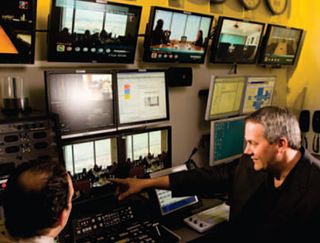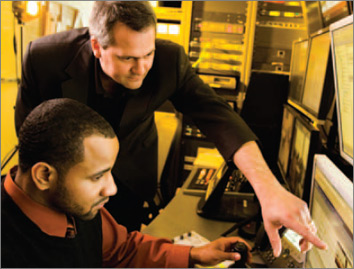In our global economy, the average workday begins long before 9:00 a.m. and ends long after 5:00 p.m. Whether it is New York, Los Angeles, or Beijing, an army of AV users still need support with equipment and technology. AV is now more network-centric; and because of global business, support happens all day and night, says Dennis Murphy, executive vice president of operations and technology for systems integrator SPL Integrated Solutions.
SPL offers its customers 24/7/365 collaborative communications support, with virtual call centers in Pennsylvania, Virginia, Connecticut, Indiana, and Idaho. Murphy's resources include 100 engineers and agents in the U.S. and another 100 sub-contracted engineers and technicians worldwide. The company is a Certified Service Partner with Polycom and an Accredited Service Partner with Tandberg, which gives SPL direct access to the manufacturer's level 3 support.
"If we can't make FedEx or get a person dispatched on-site, then that is an after-hours call, says Murphy. But the after-hours window is small; for example, 2 a.m. in New York is 8 a.m. in London. So in relative terms, there is no such thing as after hours."
- A LOOK AT USC
- At the University of Southern California's (USC) Thornton School of Music in Los Angeles, calls to
- the AV help desk are cyclical.
Calls occur at the beginning of the year when instructors have returned from a semester break, and typically during midterms, and then at the end of the year, says Roldan Flores, M.A., multimedia services manager for the Thornton School of Music. Basically when the equipment is getting the most use, or near the end of the semester as the equipment is in need of maintenance.

The school has several Pro Tools labs, and instructors regularly use PowerPoint presentations and DVD video playback. The school's first line of defense at the help desk is approximately 18 work-study students. Flores notes, They can help with multimedia and basic IT problems. Upper-level PC support is directed to a special technician, or if it is multimedia equipment such as a projector, then I handle the situation personally.
Prior to each semester, Flores and his team of three full-time technicians will take his workstudy students through a full weekend of training called technology boot camp. Although he looks for some type of knowledge in AV or IT in his new hires, the boot camp covers the basics.
Faculty members reach the AV help desk by calling the multimedia help desk hotline. Workstudy students are dispatched to the classroom with walkie-talkies, if necessary. Hours for the hotline are 8 a.m. to 9 p.m. for most days. If there are special circumstances or it is over the weekend, Flores is on call via cell phone.
In the event the problem cannot be solved quickly during school hours, there are backup multimedia carts just in case. Either way, the class must be taught and it is our primary responsibility to assure that the tools are readily available for the instructor, Flores says.
THE CORPORATE PERSPECTIVE
Just as there are all shapes and sizes of business enterprises, so too are the many ways of dealing with after-hours help desk calls. Our global clients usually have first-level support. The help desk is a phone number that rolls over into the active time zone, says Christopher Maione, president of CMS Innovative Consultants, an AV consulting firm who has designed help desk management tools for global corporations.
At a large financial services firm in Boston, MA, their AV help desk is organized by region and serviced by a group of individuals who are subject matter experts. All AV support is remotely managed, so the expert can be doing something else like supporting an event while handling support calls, says John MacNeil, manager for global audiovisual services for the firm.
The firm has 70 offices in 25 countries and has one central point of contact for both AV and IT help desk calls. Per MacNeil, the system uses skills-based routing to reach the appropriate destination.
Last year, his team fielded 15,000 requests, an average of 1,250 per month. Support hours are generally 7 a.m. to 7 p.m. local time, five days per week. However, specific support hours are determined by region, he says. Currently we do not transfer help desk requests between regions. This will be resolved once we update the infrastructure in the United Kingdom and Pacific Rim. MacNeil's North American staff includes 14 people working in staggered shifts for maximum coverage. There are 19 AV support staffers worldwide, six of which are company staff and 13 are full-timers on a vendor partner maintenance contract. We use a hybrid model, he says.
Company staff is used for face-to-face customer contact, while vendor staff is system support and diagnosis.
His team also provides cross-training of AV and IT to offices that may not have staff for both, as well as end-user training for simple tasks like changing a battery in the wireless keyboard. But there are always calls where you hang up and just have to chuckle, he laughs, citing one company executive who called for help with setting up a wireless router in a daughter's college dorm room.
At a large law firm in New York City, Michael Edebohls is the conference center technology supervisor, responsible for worldwide offices. His firm does not run an official AV help desk, rather some calls go through the IT desk; if you can wait, they will call the conference center desk, he explains. For calls that come through the IT desk, they use an IT ticketing system a formal database-driven system to keep track of tickets. If the call is tagged as an emergency, then the conference center department gets an e-mail alert from the system.
Locally, Edebohls and his team support the main headquarters in downtown Manhattan in addition to a closing center and IT center across town. The levels of AV technology in use range from audioconferencing or videoconferencing and remote camera recording, down to a large flat panel display with DVD/VHS inputs and a standard conference table phone. For remote offices like the one in Providence, RI, Edebohls uses a simple web camera to see into a conference room while providing support.
If someone hit the physical power button on the display, I can't diagnose that over the phone, he says.
Support hours at his firm are seven days a week from 8 a.m. to 7 p.m. for AV only. Weekends are 9 a.m. to 5 p.m. unless by special arrangement; holidays mean that someone is on-call via cell phone. Edebohls notes that the AV and IT departments remain separate but work collaboratively, due in part to trends like remote access of devices via the Internet.
A PROACTIVE APPROACH
At international law firm Dechert LLP, based in Philadelphia, PA, AV refers to videoconferencing more than anything else. We have a very videoconferencing-focused culture. The first reaction isn't to jump on a plane. More often than not, our attorneys need to be in multiple places at the same time, says Michael Shannon, chief information officer for Dechert, who oversees technology at its 17 offices worldwide.
Dechert currently has 47 videoconferencing systems in use, mostly Tandberg and some older Polycom systems. Shannon's support team consists of two dedicated AV engineers responsible for connecting over 200 separate videoconferences a month or about 60 per week involving five or more end points each.
Rather than fielding help desk calls, which Shannon refers to as reactive, Dechert uses a proactive scheduling package based on RoomTracker software from Baarnes Consulting Group. The scheduling software is centralized for all meeting rooms for all 17 offices and includes a picture of each room and other options such as additional equipment needed or food service requests. Think of trying to book a 10-office videoconference and someone goes to a room that is already in use. You would have nine parties waiting for the meeting to start. This is why a centralized scheduling package is critical to the success of the volume of conferences we manage, says Shannon.
Dechert's AV engineers are responsible for conducting a soundcheck 30 minutes prior to the meeting, bridging the end points, and monitoring the meeting. Any additional equipment has to be there in advance, so there is no call ticket for a meeting bundled in with other incidents, he says. That leaves the help desk to handle law firm and practice group specific applications, new equipment requests, and How do I...? questions. The help desk is a reactive service. We will do root cause analysis based on reporting to address any widespread problems and also manage 80,000 separate incidents a year. The help desk is not a good fit for managing conferencing services, notes Shannon.
A LOOK AHEAD
The ways and means to handle AV help desk calls are varied and rely on technology ranging from
worldwide call centers to a single cell phone. As the global business environment continues to expand, the notion
of after hours may become a quaint idea from the not-too-distant past.
Linda Seid Frembes is a journalist and public relations consultant for the pro AV community.
Visit her atwww.frembes.com










